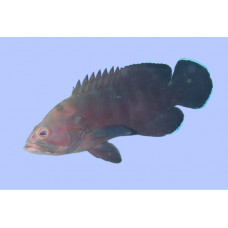Latin name
Cephalopholis boenak
Other name
Brownbarred rockcod, brown-banded cod or brown-banded rockcod.
Identification
Body of chocolate hind elongate, massive, somewhat compressed at the sides; sides covered with ctenoid scales. Body length less than head length, 2.6-3.0 times the standard body length (in individuals from 10 to 19 cm long). Head length 2.3-2.7 times the standard body length. Interorbital space flat. Preoperculum rounded, with toothed margin, angular toothing not enlarged, lower margin fleshy. Upper jaw without scales, its tip extending to a vertical line passing through the posterior margin of the eye. There are 7-9 gill stamens on the upper part of the first gill arch and 14-17 gill stamens on the lower part. There are 46-51 scales on the lateral line. There are 86-100 rows of scales along the lateral line, scales on the sides of the body without additional scales.
Features of fish fins
The dorsal fin has 9 hard and 15-17 soft rays; the membranes between the hard rays are truncated. The anal fin has 3 hard and 8 soft rays. Pectoral fins have 16-17 soft rays. The pelvic fins are shorter than the pectoral fins, their ends reaching or slightly behind the anus. The caudal fin is rounded.
Fish colouring
The body and head are brownish to greenish grey, usually with 7-8 transverse dark stripes along the sides. There is a broad dark band with a narrow white margin along the edges of the dorsal, anal and upper and lower lobes of the caudal fins. There is a blackish spot on the upper edge of the gill cover. Some individuals have radial dark brown stripes from the eye. In juveniles, the posterior part of the body is yellowish, with a white stripe running from the snout to the beginning of the dorsal fin.
Distribution
Widespread in the Indo-Pacific from eastern Africa (Kenya to Mozambique) along India and south-east Asia to the Ryukyu Islands in the north and Australia and New Caledonia in the south, including the coastal waters of Taiwan and China. Not found in the Red Sea and Persian Gulf and off the Chagos Archipelago and Maldives. However, it is found near other islands in the Indian Ocean, including the Seychelles, Comoros and Madagascar.
Habitat
Benthopelagic marine fish. Found in coastal waters on coral reefs or over muddy substrates of dead reefs at depths of 0 to 30m.
Size
Maximum length is 30 cm. Maximum recorded age: 11 years.
Behavior
They are secretive and do not migrate. Predominantly a coastal species, they can be seen on live coral.
Food and feeding habits
They eat fish and crustaceans.
Reproduction
It is a protogynous hermaphrodite. At the beginning of the life cycle most individuals are females, then some adult fish change sex and become males. Sex change occurs when females reach a length of 10 to 15 cm. Females first mature at a body length of 80 mm at the age of one year. Histological studies of male gonads have shown another developmental pathway. Some individuals are initially female and subsequently mature as males. The spawning season off Hong Kong runs from April to October.
Fishing
Subsistence fisheries.
Relationship with a person
Harmless.
| Classification | |
| Phylum | Chordata |
| Class | Actinopterygii |
| Squad | Perciformes |
| Family | Serranidae |
| Genus | Cephalopholis |
| Species | C. boenak |
| Features | |
| Conservation status | Least Concern |
| Habitat | Pelagic |
| Life span, years | 11 |
| Maximum body weight, kg | No information |
| Maximum length, cm | 30 |
| Sailing speed, m/s | No information |
| Threat to people | Edible |
| Way of eating | Predator |
Chocolate hind
Tags: chocolate hind

